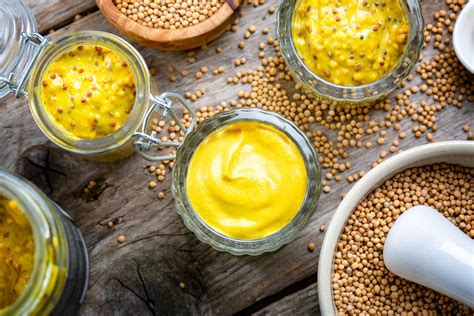The Golden Goodness of Mustard: A Culinary and Medicinal Marvel
Mustard: A Culinary Staple with a Rich History
Mustard, derived from the Brassicaceae family, has played a pivotal role in culinary traditions for centuries. Its distinct, pungent flavor has captivated palates worldwide, adding zest and complexity to a wide range of dishes. From humble beginnings in ancient Egypt to its widespread use in modern gastronomy, mustard's culinary journey is a testament to its enduring appeal.
Beyond Flavor: The Medicinal Attributes of Mustard

While known primarily as a flavor enhancer, mustard also boasts impressive medicinal properties. Its active compound, sinigrin, breaks down into allyl isothiocyanate (AITC) when mixed with water, providing valuable health benefits:
-
Anti-inflammatory: AITC inhibits inflammatory enzymes, reducing swelling and pain in conditions like arthritis and asthma.
-
Antioxidant: Mustard is rich in antioxidants, protecting cells from free radical damage linked to aging and chronic diseases.
-
Antimicrobial: Studies suggest that mustard's compounds can inhibit the growth of bacteria, yeasts, and molds.
-
Cholesterol-lowering: The soluble fiber in mustard helps lower cholesterol levels by binding to it in the digestive tract.
-
Detoxifying: Mustard seeds promote the body's natural detoxification processes, eliminating harmful substances.
The Many Faces of Mustard
The culinary versatility of mustard is reflected in its diverse forms:
Mustard Pastes
-
Brown Mustard: A bold, spicy mustard made from brown mustard seeds.
-
Yellow Mustard: A milder, sweet-hot mustard made from yellow mustard seeds.
-
Dijon Mustard: A creamy, tangy mustard from the Burgundy region of France.
Prepared Mustards
-
Honey Mustard: A versatile condiment made by combining mustard with honey for a sweet and tangy flavor.
-
Spicy Brown Mustard: A fiery mustard with a kick, perfect for adding heat to grilled meats and sandwiches.
-
Whole-Grain Mustard: A rustic mustard with whole mustard seeds for a coarse texture.
Harvesting and Processing Mustard
Mustard cultivation begins with seed planting in spring. As the plants grow, they produce clusters of small, yellow flowers. Harvesting typically occurs in late summer or early fall when the seeds reach maturity. The seeds are then processed to remove their hulls and ground into a fine powder or paste.
Economic Significance and Nutritional Value
Mustard is a globally cultivated crop, with India, Canada, and Nepal being major producers. It contributes significantly to agricultural economies worldwide. In addition to its culinary and medicinal uses, mustard also holds nutritional value:

| Nutrient |
Amount per 100g |
| Calories |
354 |
| Protein |
25.2g |
| Fat |
30.1g |
| Carbohydrates |
25.1g |
| Fiber |
10g |
| Calcium |
363mg |
| Phosphorus |
504mg |
| Iron |
6.8mg |
| Magnesium |
220mg |
| Zinc |
4.4mg |
Inspirational Stories of Mustard's Medicinal Power
Throughout history, countless individuals have witnessed the remarkable healing properties of mustard:
-
King Henry VIII: The infamous Tudor monarch reportedly used mustard baths to soothe his gouty feet.
-
Medieval Physicians:Mustard was commonly prescribed for ailments ranging from toothaches to skin infections.
-
Soldiers in World War I: Mustard plasters were used to treat wounds and relieve pain on the battlefield.
Tips and Tricks for Using Mustard Effectively
-
Choose the right mustard: Different mustards offer distinct flavors and heat levels. Experiment to find the one that best suits your taste buds.
-
Add it to marinades: Mustard's acidity helps tenderize meats and infuses them with flavor.
-
Use it as a dipping sauce: Pair mustard with pretzels, chips, and vegetables for a tangy appetizer.
-
Spread it on sandwiches: Mustard adds a burst of flavor and moisture to sandwiches, wraps, and burgers.
-
Add it to dressings: Mustard can provide a tangy kick to salad dressings, vinaigrettes, and sauces.
Step-by-Step Guide to Making Homemade Mustard
Making your own mustard is a rewarding and simple process:
-
Gather your ingredients: You'll need mustard seeds, water, vinegar, salt, and sugar (optional).
-
Grind the seeds: Use a spice grinder or mortar and pestle to grind the mustard seeds into a fine powder.
-
Mix with liquids: Gradually add water and vinegar to the ground seeds, stirring constantly until you reach the desired consistency.
-
Season to taste: Add salt and sugar to taste. Adjust the vinegar amount to achieve the desired sourness.
-
Let it steep: Allow the mustard to steep for at least 30 minutes before using to let the flavors meld.
Call to Action
Incorporate the golden goodness of mustard into your culinary repertoire and reap its health-promoting benefits. Experiment with different types and flavors to enhance the taste of your meals and promote your overall well-being.
